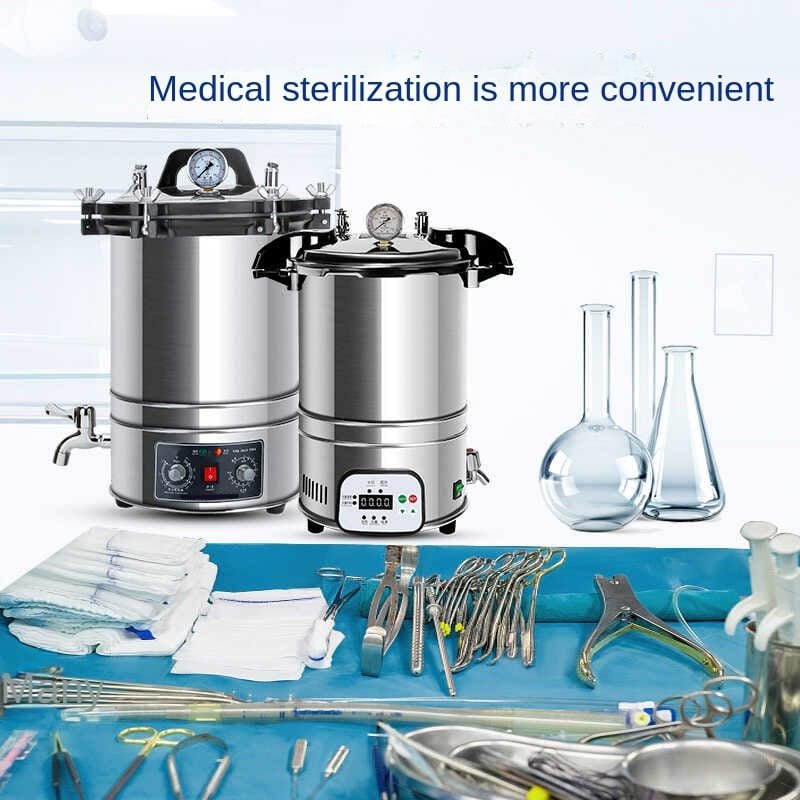

Autoclaves utilize pressurized steam to increase the internal chamber temperature beyond 121°C (250°F). The combination of extreme heat and high pressure effectively destroys all microorganisms including spores found on items undergoing sterilization. The sterilization process achieves complete reliability and guarantees comprehensive eradication of microorganisms.
The main compartment of the autoclave holds items during the sterilization process. The autoclave chamber is built to endure both high pressure and high temperature conditions.
The control panel enables users to configure and observe essential parameters including temperature levels, pressure settings and cycle duration.
The pressure gauge checks the chamber pressure to maintain operational safety during the sterilization process.
The Door Safety Lock secures the door shut during sterilization cycles to prevent any accidents.
The Steam Generator creates the steam needed to perform sterilization.
The drain valve eliminates surplus water post-cycle to preserve the autoclave’s operational efficiency.
Autoclaves sterilize surgical instruments alongside medical devices and dressings to prevent infections.
The laboratory uses sterilization techniques for glassware and media as well as lab tools to maintain accurate experimental results free from contamination.
The industrial application of sterilization includes the treatment of equipment and materials used in manufacturing processes for both pharmaceutical and food production sectors.
Autoclaves stand as the top sterilization choice because they combine effectiveness with reliability and versatility.
This sterilization method eliminates every known microorganism as well as spores.
Reliable: Provides consistent results when used correctly.
The sterilization system is capable of handling diverse materials including both liquid and solid forms.
Autoclaves serve as essential equipment that maintains sterility across medical facilities laboratories and industrial operations. Users who understand autoclave functionality and components can optimize performance while ensuring workplace safety. Only with correct operation and upkeep can autoclaves produce dependable sterilization outcomes.
The standard sterilization temperature is 121°C (250°F) at a pressure of 15 psi (pounds per square inch).
Plastics, chemicals and specific liquids are not compatible with autoclaving procedures. Always check the manufacturer’s guidelines.
The duration of a typical autoclave cycle spans from 15 to 20 minutes but changes based on the specific items being sterilized and the type of autoclave used.
Autoclaves employ steam with pressure to sterilize materials whereas dry heat sterilizers achieve sterilization through hot air. The majority of materials experience speedier sterilization through autoclaves.
Maintaining optimal performance of autoclaves requires servicing them once annually or following manufacturer guidelines.
This article offers a complete explanation of autoclaves which allows readers to easily grasp their significance and operational capabilities. Please tell me if you want to continue with the following article.

The autoclaving process serves as an essential sterilization practice utilized across medical, laboratory, and research facilities to protect glassware and instruments through effective sterilization. High-pressure steam eliminates pathogens during this

The autoclaving process serves as an essential sterilization practice utilized across medical, laboratory, and research facilities to protect glassware and instruments through effective sterilization. High-pressure steam eliminates pathogens during this
The autoclaving process serves as an essential sterilization practice utilized across medical, laboratory, and research facilities to protect glassware and instruments through effective sterilization. High-pressure steam eliminates pathogens during this
The autoclaving process serves as an essential sterilization practice utilized across medical, laboratory, and research facilities to protect glassware and instruments through effective sterilization. High-pressure steam eliminates pathogens during this
The autoclaving process serves as an essential sterilization practice utilized across medical, laboratory, and research facilities to protect glassware and instruments through effective sterilization. High-pressure steam eliminates pathogens during this
The autoclaving process serves as an essential sterilization practice utilized across medical, laboratory, and research facilities to protect glassware and instruments through effective sterilization. High-pressure steam eliminates pathogens during this